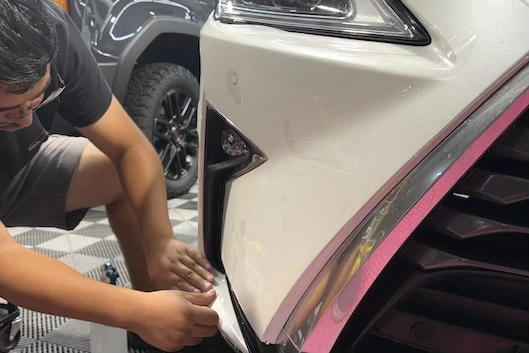How to Care for Your Paint Protection Film

Paint Protection Film Maintenance Tips & Common Mistakes
You invested in Paint Protection Film to shield your vehicle from UV, rock chips, and desert abrasion. Now keep that protection working and looking its best. Tucson’s climate demands some attention, but with the right care, high-quality PPF (like Apeax) can last 5–10 years and still look invisible. This guide walks you through what to do, what to avoid, and how to get the most out of your film.
First 7–10 Days: The Cure Period
Most PPF installations need a short “cure” window, typically the first week to ten days, before you subject them to aggressive washing or pressure.
- Do: Keep the vehicle out of excessive moisture if possible. Light rinses are okay after 48–72 hours depending on installer guidance.
- Don’t: Use high-pressure wash guns directly on edges, aggressive scrubbing, or abrasive pads during this period.
Tip: Your installer (we do this at Cool Auto Detail) will give you the exact window; mark it and treat it gently.
Regular Washing Routine
Frequency: Weekly to biweekly depending on driving conditions (dusty, off-road, or heavy debris exposure means more frequent rinses).
Steps:
- Rinse first to knock loose grit off the surface. Use a gentle flow, not a concentrated spray at film seams.
- Use a pH-neutral, ammonia-free car shampoo. Mix in a clean bucket; avoid dish soap or household detergents.
- Two-bucket method: One with clean soapy water, one with rinse water to avoid reintroducing grit. After your installation, Cool Auto Detail will send you a short video explaining this process so you can see the correct washing technique.
- Soft microfiber mitt or sponge: Light pressure, straight-line motions (avoid circular scrubbing that can introduce swirl marks).
- Rinse again thoroughly.
- Dry with a clean, plush microfiber towel or air dry.
Products & Tools to Use (and Avoid)
Use:
- Apeax-recommended maintenance sprays or mild detailers
- Soft microfiber towels
- pH-neutral automotive soaps
- Clay bar or gentle decontamination products (occasional, only if needed and done properly by a professional)
Avoid:
- Ammonia-based cleaners (especially on edges early)
- Abrasive polishes or compounds unless approved by your installer
- Harsh brushes or scouring pads
- Automatic touchless systems with aggressive detergent cycles (hand washing is safest)
After Care: Microfiber Washing & Drying
Proper care for your microfiber towels helps keep your PPF looking flawless.
- Wash microfiber towels separately from other fabrics to prevent lint transfer.
- Use a mild, fragrance-free detergent (no fabric softeners or bleach).
- Wash on a gentle cycle in warm water.
- Hang dry on a drying rack to protect the fibers. Avoid using high heat or tumble dryers, which can damage fibers and reduce softness.
- Store clean towels in a sealed bin or bag to prevent dust contamination between uses.
Dealing with Minor Marks (Self-Healing)
Many Apeax and premium PPFs have a self-healing topcoat:
- How it works: Light swirl marks or fine scratches can “disappear” with heat. Park in the sun briefly or use warm (not boiling) water.
- Don’t overheat: Use natural sunlight or warm water; avoid excessive heat sources that could stress adjacent hardware.
(Combining this with periodic inspections, like you'd get with one of our maintenance plans, keeps small issues from growing.)
Common Mistakes to Avoid
- Rushing washes and dragging dirt across the film
- Using household glass cleaners or ammonia-based sprays
- Ignoring edge lift early (if you see peeling/edge separation, get it inspected before it worsens)
- Skipping periodic inspections (contamination can get trapped under lifted edges and cause staining)
- Washing and heat-drying microfiber towels (can damage fibers, leaving lint or micro-scratches)
- Using unbalanced pH soaps or cleaners (can prematurely wear the topcoat or leave residue)
- Using improper or poorly maintained microfiber towels (dirty towels can re-introduce debris and cause swirl marks)
Seasonal / Climate Tips for Tucson
- After dust storms or monsoon debris: Rinse ASAP to prevent abrasive particles embedding.
- High-UV months: Consider parking in shade or using car covers when possible to reduce cumulative sun stress (film protects, but care still helps longevity).
- Temperature swings: Avoid immediate cold rinses on hot surfaces. Give the vehicle a moment to equalize to prevent thermal shock around seals.
When to Get a Professional Check
- Every 6–12 months (many clients pair this with an automated “maintenance check” or inspection).
- If you notice edge lifting, discoloration, or trapped contamination.
- Before selling or trading in the vehicle. A documented PPF condition helps demonstrate care and value.
Need help? Schedule a tune-up as part of your custom protection plan
FAQ
- Can I pressure wash my PPF?
Yes, but not too close or aggressive. Keep the nozzle at a safe distance and avoid blasting seams, especially during the cure period.
- Will PPF yellow over time?
High-quality films like Apeax are formulated to resist yellowing; proper maintenance and avoiding harsh chemicals prevent premature aging.
- Can I wax or coat over PPF?
Yes. Many customers layer a ceramic coating on top for added hydrophobic performance and ease of cleaning; just use compatible products.
- What if I see lifting or peeling? Schedule an inspection right away. Early intervention often prevents bigger repair/replacement needs, which is part of the proactive protection package.




